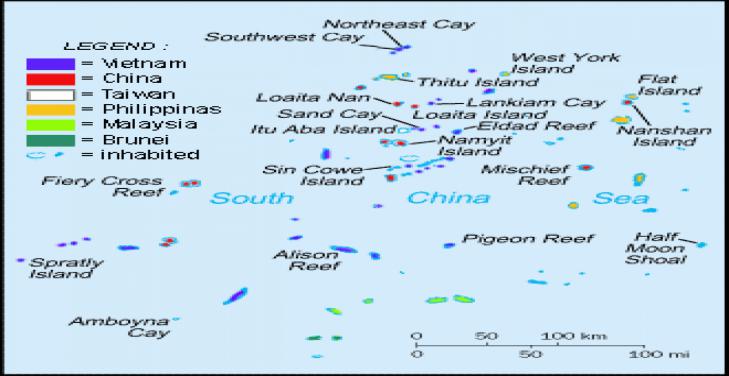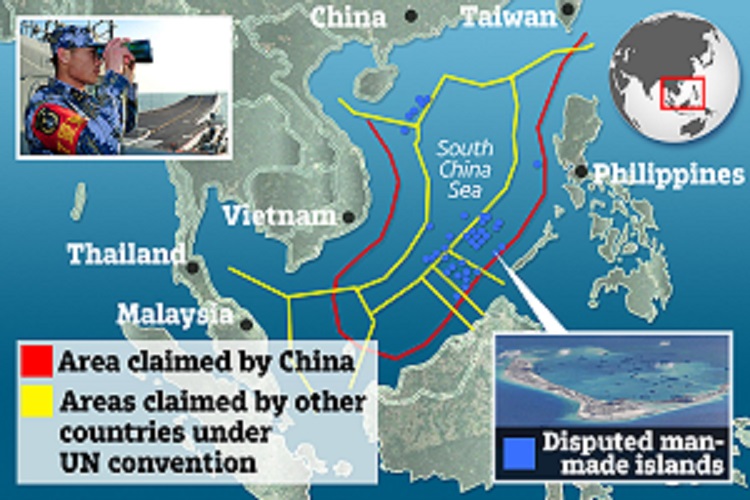The concept of “Satyam-eva Jayate” (a part of a mantra from the Hindu scripture Mundaka Upanishad) which means “Truth alone triumphs”, seems to be far away from China’s comprehension, witnessing its belligerent behaviour in general and in relation to the South China Sea in particular. The South China Sea has been a confusing conundrum and this article makes a modest attempt to decipher this conundrum, albeit in a very limited manner.
Indisputably one of the world’s busiest waterways, the South China Sea has been subject to several overlapping territorial disputes involving China, Vietnam, the Philippines, Taiwan, Malaysia, and Brunei. The conflict has remained unresolved for decades,
The article would be covered as follows:
- Brief History of the South China Sea Dispute
- India’s Stakes in the South China Sea Dispute
- Efforts by South East Asian Nations to thwart China’s Unreasonable Ambition
- India’s Stakes in the region and support to Stabilisation of South China Sea Area
- Global concerns Related to the South China Sea
- The emergence of QUAD and relevance to South China sea
- Conclusion
- History of the South China Sea claims 1
One of the world’s busiest waterways, the South China Sea is subject to several overlapping territorial disputes involving China, Vietnam, the Philippines, Taiwan, Malaysia, and Brunei. Historically, till the end of the Second World War, no claimant had occupied a single island in the entire South China Sea. Then in 1946, China established itself on a few features in the Spratlys. In early 1947, it also snapped up Woody Island, part of the Paracel Islands chain, only two weeks before the French and Vietnamese intended to make landfall. Then, Vietnam, being denied its first pick, settled for the nearby Pattle Island. The race for the occupation of the islands in the region started in 1955. By the early 1970s, issues relating to claims were raised again after oil was discovered beneath the South China Sea waters. Since 2002, the Association of Southeast Asian Nations (ASEAN) has been trying to find an amicable solution to this vexed issue bur unreasonable attitude of china has thwarted all such efforts.
In addition to the above, China has deliberately ignored the decisions of various tribunals to resolve the disputes, which has exacerbated the problem. Thus, constant refusal by China to see the reason has been the root cause for South China Sea Disputes.

- India’s Stakes in the South China Sea Dispute
The above opinion has also been supported by Global Conflict Tracker (CFR 2020)2 which has brought out that China’s sweeping claims of sovereignty over the sea—and the sea’s estimated 11 billion barrels of untapped oil and 190 trillion cubic feet of natural gas—have antagonized competing claimants Brunei, Indonesia, Malaysia, the Philippines, Taiwan, and Vietnam. As early as the 1970s, countries began to claim islands and various zones in the South China Sea, such as the Spratly Islands, which possess rich natural resources and fishing areas.
- Efforts by South East Asian Nations to Thwart China’s Unreasonable Ambitions3
In comparison to China, the Philippines, Vietnam, Brunei, Taiwan, and Malaysia are much smaller countries. As these counties would not be in a position to take an independent stance or any action against an emerging superpower like China on their own, they are keener to garner U.S. and India’s support and as it may help them in stemming China’s belligerence and also help in forming a larger regional bloc against China. ASEAN also is one of the steps initiated in that direction.
- India’s Stakes in South China Sea Dispute4
It is important to note that developments in the South China Sea situation would be critical for India’s security and well-being. In the first place, the South China Sea is not China’s sea but a global common. Second, it has been an important sea-lane of communication since the very beginning, and passage has been unimpeded over the centuries. Third, Indians have sailed these waters for well over 1,500 years — there is ample historical and archaeological proof of a continuous Indian trading presence from Kedah in Malaysia to Quanzhou in China. Fourth, nearly $200 billion of Indian trade passes through the South China Sea and thousands of Indian citizen’s study work and invest in ASEAN, China, Japan and the Republic of Korea. Fifth, India has stakes in the peace and security of this region in common with others who reside there, and freedom of navigation, as well as other normal activities with friendly countries, would be essential for India’s economic well-being. In short, the South China Sea is would remain India’s business. India has historical rights established by practice and tradition to traverse the South China Sea without impediment. The proposition that nations that have plied these waters in the centuries past for trade and other peaceful purposes are somehow outsiders who should not be permitted to engage in legitimate activity in the South China Sea, or have a voice without China’s say, should be firmly resisted.
- India’s Support to Stabilisation of South China Sea Area5
The South China Sea is one of the most difficult and contentious maritime conflicts in the Asia Pacific. Several scholars have echoed the sentiments that the South China Sea conflict would be a worst-case threat to peace and stability in the region. The concerns are further strengthened with China’s continued military build-up, despite the 2002 Joint Declaration on the conduct of parties in the South China Sea. China’s assertive posture in the South China Sea is of great concern especially with India unfolding its Act East Asia Policy.
The Current Indian Government has realised the importance of the South China Sea both in terms of its geo-economic and strategic interests. To further strengthen the relationship with South-East Asian countries, India pledges to be a credible security provider. At the 2014 East Asian Summit, India along with the United States and Vietnam affirmed its support to safeguard maritime security and freedom of navigation. Further, India has been very vocal in settling the dispute through peaceful means and in accordance with the UNCLOS.
The Indo-Pacific QUAD with India, Japan, Australia and the United States further revitalises India’s presence in the region. Thus, the adoption of the Indo-Pacific region into the strategic framework has cumulatively summed up the relevance of the South China Sea for India.
- Global Concerns2
In recent years, satellite imagery has shown China’s increased efforts to reclaim land in the South China Sea by physically increasing the size of islands or creating new islands altogether. In addition to piling sand onto existing reefs, China has constructed ports, military installations, and airstrips—particularly in the Paracel and Spratly Islands, where it has twenty and seven outposts, respectively. China has militarized Woody Island by deploying fighter jets, cruise missiles, and a radar system.
To protect its political, security, and economic interests in the region, the United States has challenged China’s assertive territorial claims and land reclamation efforts by conducting FONOPs and bolstering support for Southeast Asian partners. Also in response to China’s assertive presence in the disputed territory, Japan has sold military ships and equipment to the Philippines and Vietnam in order to improve their maritime security capacity and to deter Chinese aggression.
- Emergence of QUAD and its relevance to South China Sea6
Analysts have felt that China’s recent moves, including its aggression in the South China Sea and transgressions and deadly clashes across the Line of Actual Control (LAC), may in fact prove to be the tipping point that would make India take the plunge, pushing the countries of the Quadrilateral Security Group, called the Quad for short, into a military embrace that will have far-reaching implications for regional and global security.
Ironically, the Quad, which currently engages in laboured and slow-paced discussions, was originally born in an instant: from the crisis that followed the tsunami in December 2004. Within days of the disaster, India had mobilised an impressive fleet and demonstrated to the world that it would not just manage its own rescue effort in Tamil Nadu and the Andaman and Nicobar islands but could also provide assistance to its maritime neighbours: Sri Lanka, the Maldives and Indonesia. In between QUAD became a bit dormant.
But, in 2017, the Quad returned, now named Quad 2.0, coinciding with the revision in Washington’s assessment of the challenge from China, and similar reassessments in New Delhi, Tokyo and Canberra. In November 2017, just months after the Doklam stand-off between the Indian Army and the PLA, officials from all four countries have been focusing on “connectivity, sustainable development, counter-terrorism, non-proliferation and maritime and cybersecurity, with a view to promoting peace, stability and prosperity in an increasingly inter-connected Indo-Pacific region”.
India has also strengthened its naval ties with each of the other Quad countries, and there have been more interactions, formal and informal at the official, political and military levels. India’s moves with the Quad will be thus closely watched, as they bear more meaning than ever before on the path it will take to realise the amalgamated strategic future.
- Conclusion
Concept of “Satyam-eva Jayate” – Truth alone triumphs” ( a part of a mantra from the Hindu scripture Mundaka Upanishad) seems to be far away from China witnessing its belligerent behaviour in general and in relation to the South China Sea in particular. The South China Sea has been a confusing conundrum and this article has made an attempt to decipher this conundrum albeit in a very limited manner.
China’s sweeping claims of sovereignty over the South China Sea has been the root cause for the South China Sea disputes, which threaten the stability in the region.
The South-East Asian nations have been more keen on garnering U.S. and India’s support and as it may help them in stemming China’s belligerence and also help in forming a larger regional bloc against China. ASEAN also is one of the steps initiated in that direction.
India has stakes in the peace and security of this region in common with others who reside there, and freedom of navigation, as well as other normal activities with friendly countries, would be essential for India’s economic well-being. In short, the South China Sea is would remain India’s business.
India needs to unfold its maritime security posture and interests; there would be a strong commitment from the Indian side to realign with several South-East Asian countries. India’s participation in several East Asian forums has been seen as a counterbalance move initiated by the Southeast Asian countries. Thus India is welcomed as an external balancer along with the United States.
China’s hegemonic claims in the South China Sea and its belligerent actions have posed a great threat to economic wellbeing and security of the South East Asian region including India and has also jeopardised stability in the Asia Pacific region.
The Quad grouping has realised the need to counter the hegemonic claims of China and has been meeting and taking many steps to build an effective counter to the Dragon. India’s moves with the Quad will be closely watched, as they bear more meaning than ever before on the path it will take to realise the amalgamated strategic future.
However, the question still remains whether Chain will be amenable to the diplomatic solution or would force a military conflict that may the potential to trigger a mini “Third World War”? Further research on this aspect would be needed.
Title Image Courtesy: https://www.thesun.co.uk/news/11589123/
Disclaimer: The views and opinions expressed by the author do not necessarily reflect the views of the Government of India and Defence Research and Studies.
References:-
- Khalid Zaka: 10 Sep 2020, STRAIGHT, A summary of the South China Sea conflict, Retrieved from https://www.straight.com/news/khalid-zaka-a-summary-of-south-china-sea-conflict, accessed on 09 & 10 Oct 2020
- Global Conflict Tracker , Oct 2020, Council on Foreign Relations, Territorial Disputes in South China sea , https://www.cfr.org/global-conflict-tracker/conflict/territorial-disputes-south-china-sea
- Vietnam, ASEAN, and the South China Sea: Unity or Diverseness? * Tomotaka Shoji 2012 originally published in Japanese in Boei Kenkyusyo Kiyo (NIDS Security Studies), Vol. 14, No. 1, December 2011. Some parts are updated. ** Senior Fellow, Regional Studies Department. Retrieved from: **http://www.nids.mod.go.jp/english/publication/kiyo/pdf/2012/bulletin_e2012_2.pdf
- Vijay Gokhale, Jun 2020, Indian Express, How the South China Sea situation playout will be critical for India’s security. Retrieved from: https://indianexpress.com/article/opinion/columns/south-china-sea-dispute-asean-countries-relations-vijay-gokhale-6460680/
- Priya Suresh, 2018, Takshshila, India a Vital Player in South China Sea., Retrieved from https://takshashila.org.in/india-a-vital-player-in- south-china-sea/
- Suhasini Haidar, 25 Jul 2020, The Hindu, Quad | The confluence of four powers and two seas, Retrieved from https://www.thehindu.com/news/international/quad-the-confluence-of-four-powers-and-two-seas/article32192770.eceUPDATED: JULY 26, 2020 10:08 IS
Title image courtesy: https://www.thesun.co.uk/news/11589123/
Disclaimer: The views and opinions expressed by the author do not necessarily reflect the views of the Government of India and Defence Research and Studies.





